Less Is More
Three ETFs to Own Forever
- Three distinct ETFs provide exposure to long-term Innovation, Consumption & Income
- Leading innovators reinvest 26% of sales in R&D and Capital Expenditures
- Very few ETFs reinvest dividends automatically and pass along commission savings
- Even indexed ETFs can produces significant variance in returns over time
Simplicity can be beautiful. Distilling an investment theme into one word often helps crystalize a thesis and focus the objective. This year for example it would be Oil… as in oil fell too far in Q1 and well-capitalized drillers got too cheap, creating deep value opportunities. Brexit and Income also come to mind. I mention the strategy because a seasoned and somewhat cynical investor recently asked me which stocks I’d want to own forever, if I could only buy three. Talk about sharpening your focus!
The more I wrestled with the question, the more I found it both plagued my intellect and tickled my imagination. What a challenge: Finding three companies which could somehow encapsulate everything exciting about investing. For me, growth would obviously have to figure prominently –we’re talking forever– but so would income and a sense of value. I ran screens of every combination imaginable, and even back-tested them over 25 year periods. Suffice to say what works in one decade doesn’t necessarily work in another.
My Ah-Ha Moment
I was beginning to think this was an exercise in absurdity, and then it dawned on me: What if I focused instead on ETFs? Specifically three which reflect three timeless themes of Innovation, Income and America’s insatiable appetite for more. Since the average stock spends only 9 years in the S&P 500 Index, choosing an ETF minimizes the risk of hitching the cart to an aging horse. True, ETFs bend the original parameters slightly, but so be it. Here are my three to own:
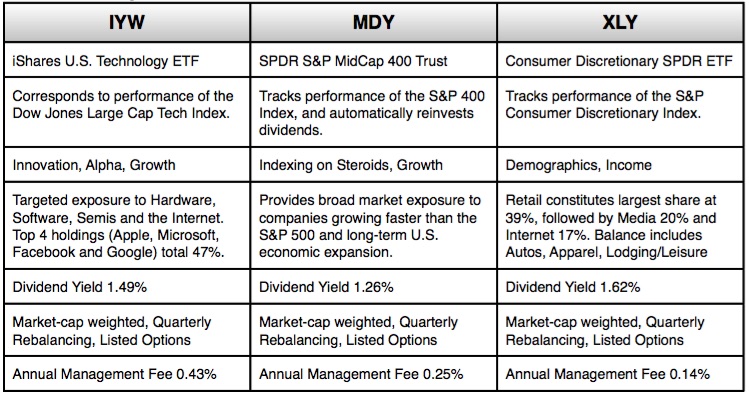
1. Innovation
In this political season of promises to “Make America Great Again” I am reminded of Ronald Regan’s message of “Morning in America” and it’s a theme which replays generation after generation. Innovation and an ability to reinvent has propelled Corning Glass through countless economic cycles, from Edison’s first light bulb to the Gorilla Glass on an iPhone. Fracking has turned the U.S. into the world’s third largest oil producer behind Russia and Saudi Arabia. Likewise, targeted immuno-therapies pioneered in the labs of Boston promise to convert virus cells into cancer killers.
The common link is technological innovation. It’s one of the reasons Google (okay, Alphabet) has become a must-own name. Tesla too if you can stomach the valuation. I know I can never pick just one company or even one vertical to capture this powerful force, so I need a team which can effectively allocate on my behalf. For this task I select BlackRock’s iShares Technology fund IYW. As I survey the top four holdings which collectively account for 47% of allocation, they tick nearly all of my boxes which define must-own game changing companies.
What Defines a Game-Changer
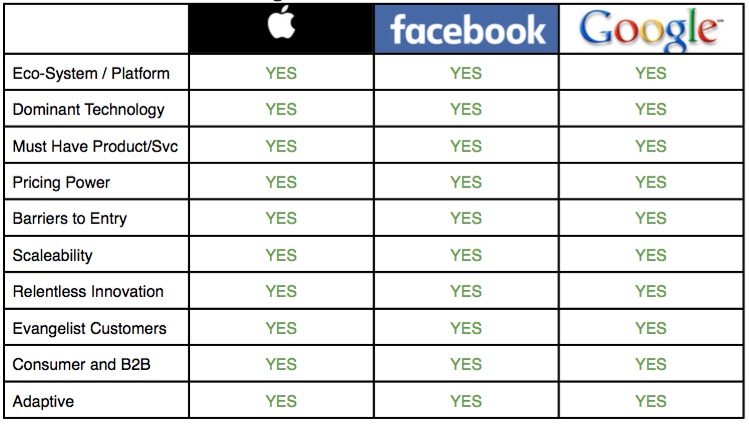
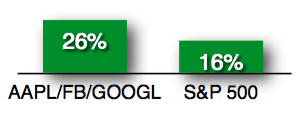 Bloomberg lists a total of 35 technology ETFs. I selected IYW because it offers the highest exposure to Apple/Facebook/Google (35% of assets). These three companies reinvest an average of 26% of sales back into R&D plus CapEx, compared to 16% for the S&P 500 Index. These companies are committing $84B annually in pursuit of new solutions. They clearly BELIEVE in their ability to innovate, which I find very attractive.
Bloomberg lists a total of 35 technology ETFs. I selected IYW because it offers the highest exposure to Apple/Facebook/Google (35% of assets). These three companies reinvest an average of 26% of sales back into R&D plus CapEx, compared to 16% for the S&P 500 Index. These companies are committing $84B annually in pursuit of new solutions. They clearly BELIEVE in their ability to innovate, which I find very attractive.
In addition, the IYW provides access to a total of 141 companies, compared to median of 69 holdings for all the tech ETFs. As a result, I think of IYW as a targeted bet with an embedded call option on a promising basket of up-and-comers. Buy it. Hold it. Watch it grow.
2. Turbo-Charged Indexing
The S&P 500 Index serves as the U.S. equity index of choice, but it’s hardly representative. It constitutes only the largest 500 publicly traded companies, meaning it excludes about another 3,500 trading on the NASDAQ and NYSE, or 6,000 if you include micro caps traded off-exchange.
While looking at big companies like GE (GE) and Exxon (XOM) might seem intuitively safer from a longterm point of view, these companies are generally not growing as quickly as their slightly smaller mid-cap brethren. What’s more, risk-adjusted returns measured by Sharpe Ratios are actually quite similar (0.49 for MID vs 0.52 for SPX currently), meaning you give up very little to capture additional potential upside. The switch can make a big difference over time. $100 deployed 25 years ago into The MidCap Total Return Index (dividends reinvested) is worth $1,139 today, compared to $896 for the S&P 500 Index.
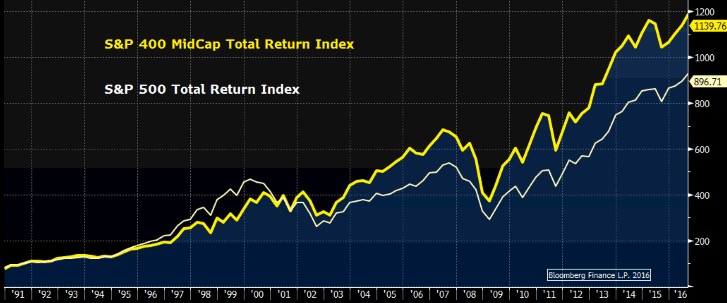
There are several ETFs which provide exposure to the Mid-Cap Index but only the MDY reinvests dividends automatically. It’s able to do this because it’s structured as a unit trust, whereas the other funds simply credit your account with the dividend and you have to reinvest it yourself… incurring commission charges along the way that could potentially eat into returns. Given an annual cost of just 0.25%, the people at SPDR are giving the low-cost for at Vanguard a run for their money. If you are fundamentally supportive of long-term GDP growth, population growth, and inflation, the MidCap Index provides far greater upside with minimal incremental risk. I think of it as indexing on steroids.
3. More, More, More
“Life, Liberty & the Pursuit of Happiness” constitutes a uniquely American perspective which has created a generational engine of growth unlike any other country in the world. By creating an inclusive environment which attracts talented and motivated 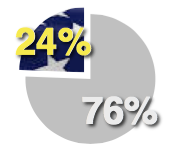 entrepreneurs (Mr. Trump, are you listening?) free of regulation and onerous taxes (ahem, Ms. Clinton?), the U.S. produces 24.4% of world GDP with just 4.5% of the world’s population. This is an incredible testament to U.S. productivity, which speaks loud and clear of the American Dream. While oil-rich countries with smaller populations like Kuwait and Norway can claim higher per capita figures, the average American household earns $53,657 per year. More importantly for our purpose as investors, Americans spend approximately two-thirds of this income consuming products and services (the balance goes to taxes and savings). –> There’s a reason why former Fed Chair Greenspan called Wal-Mart each month to track consumer expenditures…
entrepreneurs (Mr. Trump, are you listening?) free of regulation and onerous taxes (ahem, Ms. Clinton?), the U.S. produces 24.4% of world GDP with just 4.5% of the world’s population. This is an incredible testament to U.S. productivity, which speaks loud and clear of the American Dream. While oil-rich countries with smaller populations like Kuwait and Norway can claim higher per capita figures, the average American household earns $53,657 per year. More importantly for our purpose as investors, Americans spend approximately two-thirds of this income consuming products and services (the balance goes to taxes and savings). –> There’s a reason why former Fed Chair Greenspan called Wal-Mart each month to track consumer expenditures…
So as I reflect on what I want to own forever, I want an index which allows me to participate both in aggregate growth and aggregate spending, since in the U.S. the are synonymous. You can see their relationship quite clearly when we chart population and GDP against the Dow Jones Industrial Average over the past 50 years. As demographics rise, so do stocks. Companies are feeding, clothing supplying and sustaining a rising and more productive population.
Hand in Hand
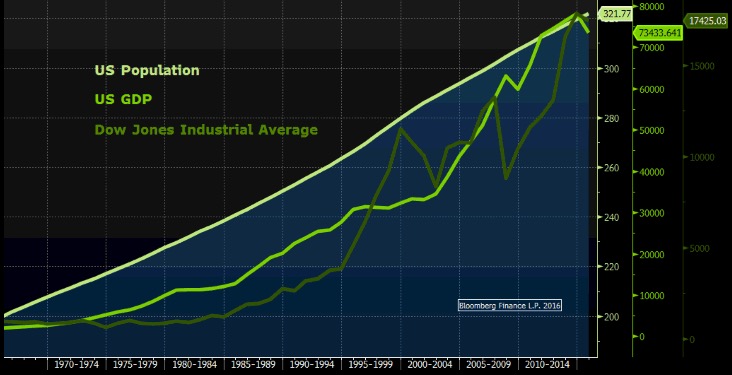
My ETF of choice in to reflect this intertwining of expansion and consumption is the Consumer Discretionary Select Sector SPDR Fund (XLY). It’s the undisputed leader among the 19 ETFs providing exposure to the consumer discretionary sector. XLY ranks number one in performance over both 5-yr and 10-year periods, generating annual returns of 17.25% and 11.36% respectively. It’s also the most liquid, with an average daily trading volume of 7.2M shares. Finally, it’s one of the most efficient, charging a fee of just 0.14% per annum.
As for allocations currently, XLY is 39% retail, 20% media and 18% Internet (which I suspect will grow over the next 5-10 years, most likely at the expense of retail as they merge ever closer). The balance of the fund is distributed across auto, apparel and entertainment. Amazon (AMZN) is the largest holding at 12.6%. The 88 components also include The Home Depot (HD), Comcast (CMCSA), The Walt Disney Company (DIS), McDonald’s Corp (MCD), Starbucks (SBUX) and Nike Inc (NKE).
Subscribe at https://bullseyebrief.com

